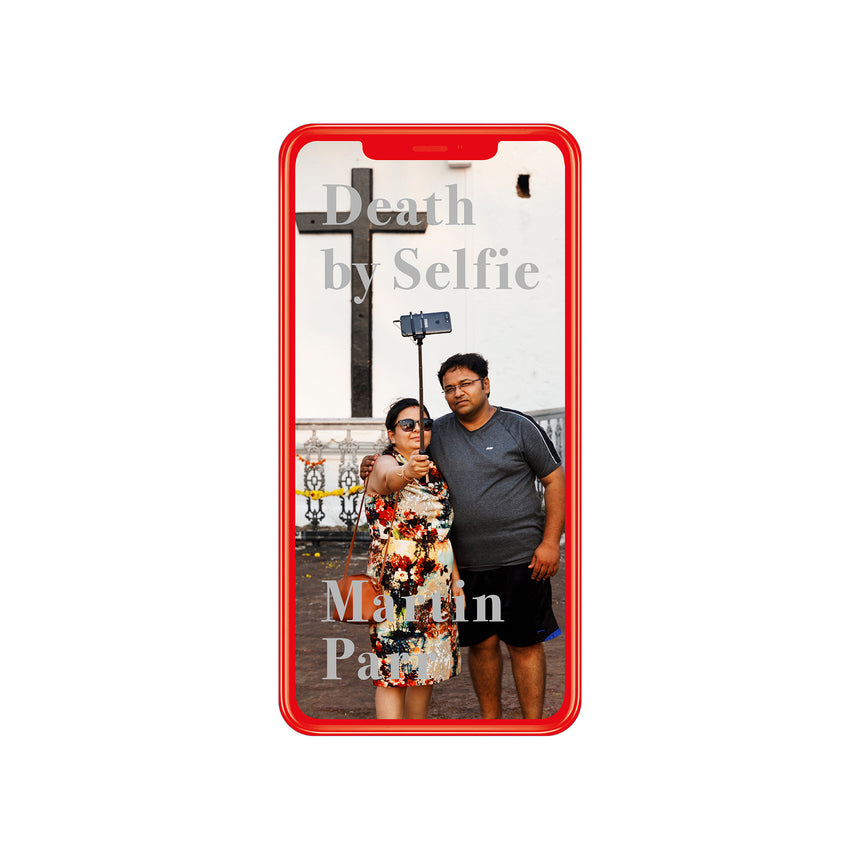Death by Selfie
Martin Parr
¥4,300 JPY
Here is an unproven statistic: India is the world leader for selfie taking. The only potential competitor would be China , with a similarly large population, but if you refer to the ‘Death by Selfie‘ statistics, India is so far ahead, there is no real competition. It is probably wise to assume that if more people are killed by a phenomenon, then more of this activity must be taking place.
In 2015, 27 people died taking selfies. In both 2016 and 2017, 68 were killed by selfies. Many of the deaths occur when other people step in to try and rescue the selfie taker washed away by freak waves. People also die by going too near a raging fire, or the often occurring stepping backwards off a cliff edge. However to India’s great credit this figure dropped substantially in 2018, down to a mere 2 deaths.
The authorities in India are aware of this hazard, and for example in Ooty at, the popular boating lake, all selfies are banned whilst boating, this despite the mandatory instruction to wear a life belt.
But on the beach of Goa, it is impossible to look round without seeing a selfie being taken. The selfie stick purveyors are also circling round and these are offered constantly along with a massage, pineapple and all of the others items and services that are available to the beach-goer.
The other observation I would make is that very rarely do selfies come singly; a typical sequence would have many dozens of options perused, and sometimes these extended sessions can take a good ten minutes. I am not sure how the editing takes place, or indeed if these selfies get saved and downloaded.
Another novelty for me is that people often request to have a selfie with me because I am a Westerner and of course I agree. So there must hundreds of images of Martin Parr floating in Indian cyberspace, untraceable autoportraits that will never be recognised.
In my quest to photograph the huge business of tourism, the introduction of the smart phone and subsequently the selfie stick have changed the ritual of a tourist visit in a dramatic fashion. I could not ignore this phenomenon and is celebrated in this small collection of images, where most are taken in India, and few other locations thrown in for good measure.
MP May 2019
w8.6 x h17.4 cm
60 Pages
32 Images(Color)
Hard cover
Full color Offset
Limited edition of 1000
Published in 2019
ISBN 978-4-908512-72-8
検証された統計ではないが、インドは自撮りが世界で最も盛んな国だ。インドに匹敵する国があるとすれば、同じように人口が多い中国だろうか。けれども、“自撮りによる死亡者数”となると、インドに遠く及ばない。勝負にならないのだ。もし、たった一つの現象でかつてないほど多くの死者が出たとすれば、きっと自撮りがそれだけ多く行われたに違いない。
2015年、自撮りをしていて27人が亡くなった。2016年と2017年には、68人が自撮りで亡くなった。その多くは、自撮りの最中に巨大な波にさらわれた人を助けようとして水に入ったのだ。燃え盛る火に接近しすぎて命を落とすとか、崖で後ずさりしてというのもよくある。それが2018年になり、賞賛すべきことに、インドでの死者は2人にまで激減したのだ。
インド当局は、こうした危険のことをわきまえている。例えば、ボートで人気のウーティ湖では、乗船中の自撮りが全面的に禁止されている。これは、救命浮輪の装備が義務づけられているにもかかわらず、である。
それなのに、ゴアの海岸では、見回せば自撮りする人が否応なく目に入ってくる。自撮り棒を貸す業者も巡回していて、パイナップルその他の物品やメッセージやサービスなど、ビーチの人々に役立つあらゆるものといっしょに絶えず勧めてくる。
このほか、私が見ていて気づいたのは、自撮りが“撮って終わり”ではないことだ。典型的ななりゆきとしては、撮った後で何十ものオプション機能を吟味し、ときには後の処理にたっぷり10分ほど費やしたりしている。うまく編集できているのだろうか。というより、こうした自撮り写真が保存されて使われたりするのかどうかさえわからない。
ほかに目新しいことといえば、私といっしょに自撮りしたいと申し込んでくる人々だ。私が西洋人だからという理由で。もちろん私は同意する。そういうわけで、インド人のサイバースペースには何百というマーティン・パーの写真が漂っているだろう。追跡しようのないこれらの自撮り写真は、誰にも認識されないだろう。
私が観光という巨大産業を取材している間に、スマートフォンに続き自撮り棒が登場して、旅行の習慣を劇的に変えた。この現象は無視できるものではなく、この本に収められたわずかな写真にも顕著に表われている。ほとんどはインドで撮影したが、他の場所の写真もおまけとして入れてある。
マーティン・パー
2019年5月
w8.6 x h17.4 cm
60 ページ
32 イメージ(カラー)
上製本
カラーオフセット印刷
限定1000部
Published in 2019
ISBN 978-4-908512-72-8





















